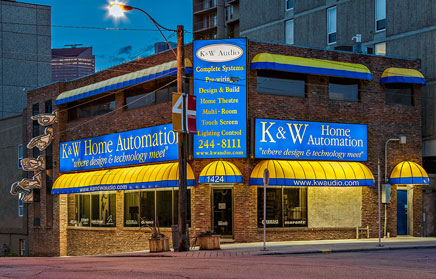Tip #47:
The ability for any display to fully resolve HDTV depends on its scanning frequency or bandwidth (think speed) combined with its resolution capability (think dots). To understand HDTV we must first recognize that the standard NTSC TV we all know and love is made up of 480 horizontal viewable lines. There are actually 525 lines in total, buts the extra lines are used for “housekeeping” duties and are not seen on the screen.
Lines are scanned across the screen at a speed of 15.75KHz, allowing display of a single full frame 30 times a second. Each full frame requires two alternating passes to make the whole picture. The first pass lights up the odd numbered lines (1, 3, 5 etc.) then, 1/60th of a second later, the remaining even numbered lines are scanned (2, 4, 6, etc.) resulting in 30 full frames of video being displayed each second. This is called interlacing, and is the “i” you see at the end of the line number.
To “line double” NTSC signals from 480i to 480p requires 2 times the 15.75KHz speed or 31.5KHz. Twice the bandwidth is needed to handle twice the picture information. Line doubling is actually a misnomer, since the same 30 frames are shown as before, but they are display completely on each pass. The lines of each frame are painted in progressive order 91, 2, 3, etc.) and to keep the speed the same, each full frame is shown twice, reducing perceived flicker and resulting in a noticeably smoother and more vibrant picture. This called progressive and is the “p” you see at the end of the line number.
This is a good time to touch on the term now often seen, 3:2 pulldown. Think of it as film reconstruction. The original film rate was 24 frames per second, which doesn’t math our video standard of 30 fps. 3:2 pull down represents the ratio of times a film frame is repeated to retime the frame rate, resulting in smoother pans. Without this extra step, a long slow pan would seem to slow down then speed up then slow down again. Upping the frame rate from 24 to 30 frames per second restores the original timing. But we digress…. We have defined our present system as showing 480 horizontal lines to make an image. Why, in our present system, do we see good and bad quality images? The answer to this question is in the number of resolving points on that horizontal line – vertical resolution. This is the number used by manufactures when they quote resolution. Defining both horizontal and vertical resolution is familiar now that most of us have computer monitors. Their resolution is usually defined, as for example 800×600. So the definition for the HDTV image is scan and horizontal rate x vertical resolution.
In the 1080i HDTV system, 1,080 picture scan lines are traced from top to bottom as interlaced fields, thus HDTV at 1080i requires a horizontal rate of 33.75 KHz. (540 lines in the first field, and 540 lines in the second) to make one frame, 30 times per second. Potentially there are a maximum of 1,920 pixels (picture-forming elements) on each line (vertical resolution). Therefore, the total image resolution is 1,920×1,080, or just over 2 million pixels. While many CRT based rear and front projectors can display 1080i HDTV many do not show all that 1080i can deliver. They cannot resolve the full 1,920 individual picture elements needed on each of the 1,080 horizontal lines to do so. If the resolution specs of a TV are less than 1,920 vertical lines, you may not be seeing everything 1080i HDTV can offer.
The 720p system scans 720 picture lines from top to bottom every 1/60th of a second, reducing flicker when compared to 1080i. This requires a horizontal rate of 44.95Khz, quite a bit more horsepower than needed with 1080i! There are 1,280 pixels on each line, resulting in a total image resolution of 1,280×720 or 921,600 pixels. However, in the same time interval that one-half of a 1080i image is shown (about 1 million pixels) all of the 720p image will be scanned, plus the full image will be displayed twice (just under 2 million pixels) in the time the 1080i format will show a complete frame once. For this reason, the 720p system has the same perceived image resolution as the 1080i system, but potentially offers an enhanced, smoother look due to it showing each image for twice the duration.
To truly offer the ability to display the HDTV highest speed requirement (720p/44.95Khz) and the maximum possible vertical and horizontal resolving capability 1080i (1,920×1,080) the display in question must be able to do it all. This means that a true HDTV capable set requires a horizontal scanning capability of 44.95Khz, at least 1,920 lines of (Vertical) resolution and 1,080 horizontal lines.
A little dose of reality comes into play here, though. Due to the fact most HD material is not actually shot at the highest possible resolution, and our satellite provider tends to save on bandwidth, coupled with the fact that all displays overscan the image (meaning that we don’t see the entire frame), the truly highest viewable vertical resolution in the 1080i system presently is around 1,440, and in most cases the number is considerably lower, sometimes as low as 540!
In the U.S., CBS television is broadcasting in the most popular 1080i format. The same holds true for NBC. US subscription services HBO and Showtime also use the 1080i format to broadcast movies and special programs. ABC Television has chosen to broadcast in 720p. Fox and WB stations are currently broadcasting 480p digital television, with no immediate plans for any true high-definition TV signals. PBS has also adopted the 1080i standard with multi-casting. When not transmitting in HDTV, broadcasters can transmit four or more channels of standard definition television (SDTV) programming simultaneously.
At present our HDTV Canadian feeds are available exclusively from satellite. They are made up from a jumble of feeds originating with one of the previously mentioned U.S. providers. A local cable provider has recently begun distribution of a cable box claiming to offer high definition, but alas the boxes we have seen have only been capable of enhanced standard definition, displaying at 480p.
The answer is Yes, if one obtains a digital converter box. By down converting the signal to a 480i resolution the programming will display on presently installed sets, but without the punch that HDTV offers. DTV information requires a different kind of receiver (tuner) than is currently installed in conventional sets, so one will need a set top box of some description. However, in order to experience the full benefits of digital television, including HDTV, viewers will need new high performance digital television sets, probably still with an off board DTV tuner, and a supplier who actually provides the signal. Hopefully this will happen sooner rather than later!


